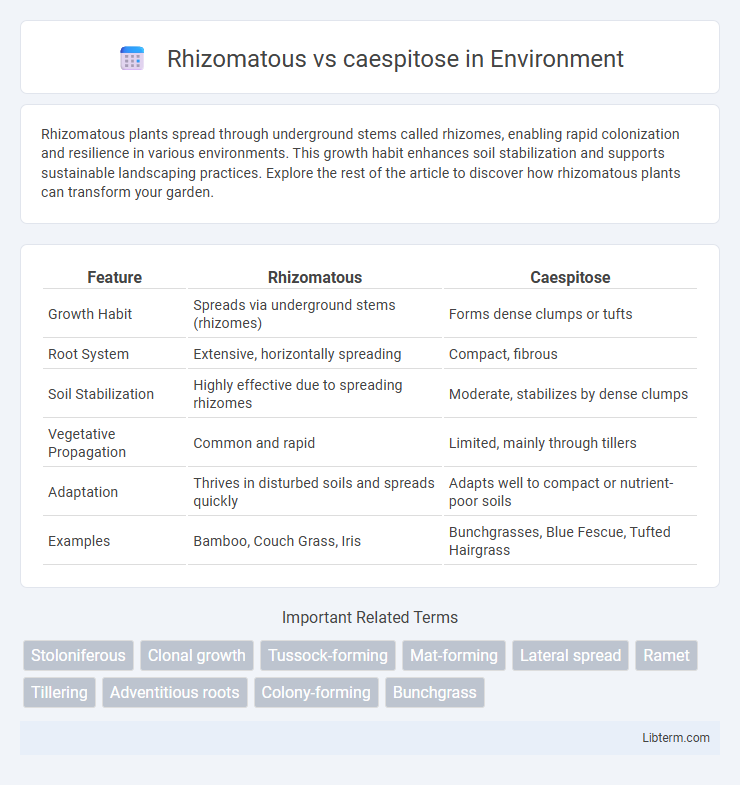Rhizomatous plants spread through underground stems called rhizomes, enabling rapid colonization and resilience in various environments. This growth habit enhances soil stabilization and supports sustainable landscaping practices. Explore the rest of the article to discover how rhizomatous plants can transform your garden.
Table of Comparison
| Feature | Rhizomatous | Caespitose |
|---|---|---|
| Growth Habit | Spreads via underground stems (rhizomes) | Forms dense clumps or tufts |
| Root System | Extensive, horizontally spreading | Compact, fibrous |
| Soil Stabilization | Highly effective due to spreading rhizomes | Moderate, stabilizes by dense clumps |
| Vegetative Propagation | Common and rapid | Limited, mainly through tillers |
| Adaptation | Thrives in disturbed soils and spreads quickly | Adapts well to compact or nutrient-poor soils |
| Examples | Bamboo, Couch Grass, Iris | Bunchgrasses, Blue Fescue, Tufted Hairgrass |
Introduction to Plant Growth Forms
Rhizomatous plants spread through underground stems called rhizomes, enabling horizontal growth and efficient colonization of new areas. Caespitose plants grow in dense tufts or clumps with tufted shoots arising closely, promoting vertical growth rather than horizontal spread. These growth forms influence plant ecology, resource competition, and habitat adaptation strategies in diverse environments.
Defining Rhizomatous Plants
Rhizomatous plants are characterized by their underground stems, called rhizomes, which grow horizontally and produce new shoots and roots from nodes, enabling efficient vegetative propagation and horizontal spreading. These plants contrast with caespitose species, which grow in dense, tufted clumps without significant lateral underground stems. Examples of rhizomatous plants include ginger, bamboo, and certain grasses, all leveraging rhizomes for resilience and rapid colonization.
Understanding Caespitose Growth
Caespitose growth refers to plants forming dense tufts or clumps with multiple stems arising close together from a single base, promoting compact and upright growth. This growth habit contrasts with rhizomatous plants, which spread horizontally through underground stems called rhizomes, enabling wider vegetative propagation. Understanding caespitose growth is crucial for habitat restoration and turf management, as these plants enhance soil stability and resist trampling due to their clustered growth pattern.
Key Morphological Differences
Rhizomatous plants feature horizontal underground stems called rhizomes that enable vegetative spread and nutrient storage, resulting in widely spaced shoots. Caespitose plants grow in dense tufts or clumps with shoots arising closely together from a short, compact stem base, limiting horizontal spread. These key morphological differences affect their growth patterns, ecological adaptation, and spatial distribution in plant communities.
Ecological Adaptations and Advantages
Rhizomatous plants possess underground stems that enable vegetative propagation, allowing rapid colonization and resilience in disturbed or competitive environments through resource sharing and space occupation. Caespitose plants grow in dense tufts or clumps with compact root systems, providing enhanced resistance to grazing, erosion, and water stress by maintaining soil stability and conserving moisture. Both growth forms offer adaptive advantages tailored to specific ecological niches, with rhizomatous types excelling in expansion and soil colonization, while caespitose species prioritize resource conservation and mechanical stability.
Examples of Rhizomatous Species
Rhizomatous species, such as bamboo (Phyllostachys spp.), ginger (Zingiber officinale), and quackgrass (Elymus repens), spread through underground stems called rhizomes, allowing rapid horizontal growth and colony formation. These plants exhibit extensive vegetative propagation, enhancing their resilience and ability to colonize new areas. In contrast, caespitose species like bunchgrasses grow in dense tufts or clumps without spreading via underground stems, leading to more localized growth patterns.
Representative Caespitose Plants
Representative caespitose plants include species such as Festuca ovina (sheep fescue), Carex spp. (sedges), and Bouteloua gracilis (blue grama), all characterized by dense, tufted growth without spreading rhizomes. These plants form compact clumps that conserve soil moisture and prevent erosion, making them vital in prairie and alpine ecosystems. Their caespitose growth habit contrasts with rhizomatous species by limiting lateral spread, promoting localized resource concentration and resilience in harsh environments.
Impacts on Cultivation and Landscaping
Rhizomatous plants spread horizontally through underground stems, promoting rapid ground coverage and erosion control, which makes them ideal for large-scale landscaping and soil stabilization projects. Caespitose plants grow in dense, tufted clumps, providing structural interest and requiring less maintenance due to slower spread, favoring use in ornamental gardens and controlled turf areas. Understanding these growth habits aids in selecting species compatible with specific cultivation goals, such as managing plant density or optimizing space utilization.
Rhizomatous vs Caespitose: Pros and Cons
Rhizomatous grasses spread through underground stems, offering excellent soil stabilization and rapid area coverage but may become invasive and harder to control. Caespitose grasses form dense clumps, which promote turf durability and reduce spread, requiring less maintenance but potentially resulting in patchy coverage. Selecting between Rhizomatous vs Caespitose depends on landscaping goals, with Rhizomatous ideal for erosion control and Caespitose preferred for low-maintenance, defined turf areas.
Choosing the Right Growth Form for Your Garden
Rhizomatous plants spread through underground stems, creating extensive, dense mats ideal for ground cover and erosion control, while caespitose plants grow in tight clumps, forming neat, upright tufts that require less space. Selecting rhizomatous species suits gardens needing rapid area coverage and natural soil stabilization, whereas caespitose types are perfect for structured designs, borders, and rock gardens where defined growth and easy maintenance are essential. Understanding these growth patterns enables gardeners to optimize plant placement for aesthetics, propagation, and long-term garden health.
Rhizomatous Infographic

 libterm.com
libterm.com